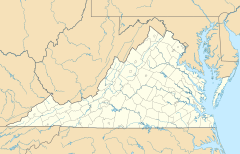Cape Charles Light
|
Cape Charles Light in 1995
|
|
| Location | Smith Island off Cape Charles at the mouth of the Chesapeake Bay |
|---|---|
| Coordinates | 37°07′23″N 75°54′23″W / 37.12292°N 75.90647°WCoordinates: 37°07′23″N 75°54′23″W / 37.12292°N 75.90647°W |
| Year first constructed | 1828 |
| Year first lit | 1895 |
| Automated | 1963 |
| Construction | cast iron skeleton tower |
| Tower shape | Octagonal pyramidal skeleton |
| Markings / pattern | lantern and watchroom, black tower, white |
| Height | 191 feet (58 m) |
| Focal height | 180 feet (55 m) |
| Original lens | First order Fresnel lens |
| Current lens | Vega VRB-25 solar-powered beacon |
| Range | 18 nautical miles (33 km; 21 mi) |
| Characteristic | Flashing white, 5 sec |
| Admiralty number | J1404 |
| ARLHS number | USA-109 |
| USCG number |
2-350 |
|
Cape Charles Light Station
|
|
| Nearest city | Kiptopeke, Virginia |
| Area | 10 acres (4.0 ha) |
| Built | 1894 |
| MPS | Light Stations of the United States MPS |
| NRHP Reference # | 03000569 |
| VLR # | 065-0071 |
| Significant dates | |
| Added to NRHP | June 23, 2003 |
| Designated VLR | December 4, 2002 |
2-350
The current Cape Charles Light is an octagonal cast iron skeleton tower lighthouse at the mouth of the Chesapeake Bay on Smith Island. It is the tallest lighthouse in Virginia and the second tallest in the United States. This particular tower is the third lighthouse at this location. The first lighthouse at Cape Charles was a 55-foot (17 m) masonry tower completed in 1828. It was quickly deemed inadequate for its important seacoast location due to its low height and poor visibility at sea. It was soon threatened by erosion so in 1864 it was replaced by a 150-foot (46 m) masonry tower built further inland. Located a little more than a mile southwest of the old tower and 600 feet from the shoreline, the impressive 150-foot-tall conical brick tower was similar in appearance to the 1857 Cape May Lighthouse, painted white and topped with a dark brown lantern room. In 1892, a twenty-five-foot red band was painted around the white tower’s midsection, about sixty feet up from the base, to make it more visible during the day. By the 1890s, it too was threatened by beach erosion which jetties built to protect it failed to halt, and with the lighthouse now only 300 feet from the ocean and the shoreline eroding at a rate of 37 feet per year it was decided that a third lighthouse needed to be built three quarters of a mile inland.
The first proposal for Cape Charles’ third lighthouse called for a conical structure of iron plates, similar in design to the new Cape Henry Lighthouse, but in the end, a bid of $78,200 was accepted to construct 191-foot (58 m) octagonal steel skeletal towers at both Cape Charles and Hog Island, a barrier island twenty miles to the north where another lighthouse was being threatened by shoreline erosion. This design had several advantages: it was much cheaper than the Cape Henry model, less susceptible to punishing winds, and distinct enough from the Cape Henry tower that the two would not be mistaken for each other.
The new station’s lens was installed and tested in June 1895, however, its full-time service was delayed until mid-August so mariners could be properly informed of the station’s new light characteristic. Lt. Frederick Mahan of the Lighthouse Board proposed that all U.S. lighthouses be given a “numerical flash” pattern. The first-order lens at Cape Charles made a complete revolution every thirty seconds, producing nine flashes: four quick flashes followed by a dark interval of three seconds, then five more flashes followed by sixteen seconds of darkness. Cape Charles would thus have a 4-5 pattern, and mariners could easily associate these numbers with Cape Charles. This numbering system was likened to a fire alarm bell stroking out the exact numerical identity of a beleaguered building. “By this method,” Mahan maintained, “the light is identified absolutely…” Due to the high cost of these special lenses, only the “4-5” light at Cape Charles, and the “1-4-3” light at Minots Ledge were ever deployed.
...
Wikipedia

